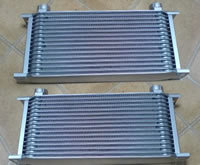Oil Coolers Heat Exchangers
Introduction
Oil cooling refers to a process to heat displaced from a cooler oil is the principle behind oil cooler devices. The oil carrying the displaced heat usually passes a cooling unit such as a radiator, less commonly a gas decompresser. The oil cooler is connected to the lubrication system in parallel the main oil pressure line. The cooled oil is returned to the crankcase of the engine. The cooled oil repeats this cycle, continuously remove heat from the object. An assembly for cooling oil in the lubrication system an internal combustion engine. Oil coolers are installed mainly in vehicles; engines often operate under difficult thermal conditions. Oil coolers may be of the air-cooled water-cooled type. The air-cooled oil cooler consists of brass tubing to which fins are soldered. The oil in the tubing by the oil pump is cooled air when the vehicle is in motion.
Specifications of Oil Coolers Heat Exchangers:
- It can be connected to through to the high-performance blocks by removing the plugs above the oil filter pad.
- It also contributes to lowering the engine-temperature.
- As it begins to break down, oil loses its lubricating, as well as its cooling, properties.
- It is a majority of cars are not manufactured with proprietary engine oil coolers, this is a large aftermarket for them, and they are common accessories in vehicles involved in towing and other heavy-duty applications.
- Oil cooling kits exist for both motors and automatic transmissions.
- It is not only functions as a lubricant but also as the coolant for a number of parts.
- Oil cooler which includes parts such as the crankshaft, bearings, camshaft, rods, and pistons, is cooled only by engine oil.
Applications of Oil Coolers Heat Exchangers:
- Oil cooling is the most promising for getting big cooling gains with relatively little effort.
- It is necessary to keep the temperature of the oil, needed for the functioning of the engine and its subsystems, under control.
- It is high temperatures lead to a rapid degradation of the oil’s lubrication characteristics with the risk of damaging mechanical parts. Oil cooler may be designed to exchange heat between oil and air rather than oil and the coolant in the engine cooling circuit.
- It is latter involves simplified oil circuits and low costs compared to the oil-air solutions, which offer higher performances and do not imply an additional thermal load for the radiator.
- An oil cooler is a separate, smaller radiator from an engine’s main radiator, which maintains an oil supply at a consistent, optimal temperature.
- Oil cooler lower oil temperatures prolong the life of an engine or transmission. An oil cooler can play an important role in the smooth running of a vehicle by dissipating heat while transporting oil away from moving parts into the oil pan.
- Oil cooler temperature for oil is between 180 and 200 degrees. Failures start to occur when oil cannot dissipate its collected heat fast enough and rises past this threshold.
Advantages:
- Oil has a higher boiling point than water, so it can be used to cool items 100°C or higher.
- Oil is an electrical insulator; it can be used inside of or in direct contact with electrical components.
Images:


